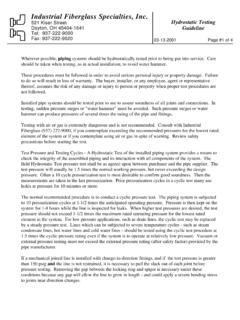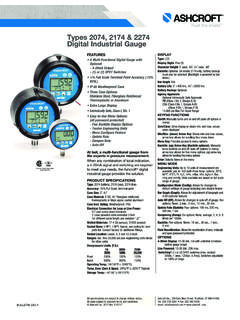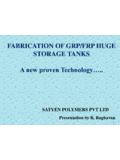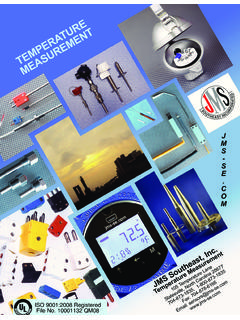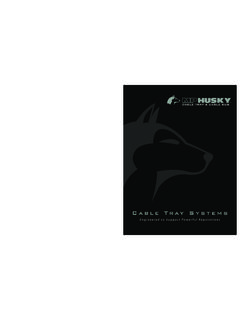Transcription of The ASME Standard - Industrial Fiberglass …
1 The asme Standard be designed, fabricated, inspected, tested, and stamped in accordance with asme . International Standard This Standard was developed under pro- for Fiberglass cedures accredited because they met the criteria for the American National Stan- dards Institute (ANSI). The committee that approved the Standard was balanced to ensure that individuals from competent Reinforced Plastic and concerned interests had an opportu- nity to participate. The document is de- signed to set the minimum safety stan- dards for the design and fabrication of Vessels is Adopted composite vessels. Those with a material interest in the document had the oppor- tunity to comment and voice their views to the committee.
2 This consensus stan- dard represents the best design, fabrica- into Delaware Code tion, and inspection technology for ber- glass-reinforced plastic (FRP) vessels available today. The asme RTP-1 Standard Commit- tee meets twice a year. Any party with a LARRY CRAIGIE, American Composites Manufacturers Association material interest in FRP vessels is encour- aged to attend meetings and to share ideas on how to improve the Standard . Delaware adopted as code the asme International Many ASTM standards have been de- Standard RTP-1-2000, Reinforced Thermoset veloped for the design of berglass vessels Plastic (RTP) Corrosion Resistant Equipment, into its civil (Figures 1 and 2).
3 One of the most com- code in accordance with the Jeffrey Davis Aboveground monly used speci cations for lament- Storage Tank Act. The act was written in memory of a man wound FRP tanks is ASTM This killed when a sulfuric acid (H2SO4) tank exploded and Standard was rst published in 1971 and is reedited and released every 5 years or collapsed in ames. Other standards exist that can so. The latest release is dated 2000. contribute to the proper design of RTP equipment. These During the 1970s, as the use of FRP. standards , however, do not provide equipment purchasers vessels for corrosive service increased, the documentation that shows whether or not vessels many more speci cations and Standard have been constructed according to a consensus Standard methods were written to assist design en- that represents the best design, fabrication, and gineers.
4 The chemical plants where tanks were installed experienced an excessive inspection technology for RTP equipment today. number of failures, mostly related to con- Because of these failures, sev- eral major chemical companies indepen- dently formed engineering groups that E. specialized in reinforced plastic equip- ment. They developed internal speci ca- ective June 11, 2004, Dela- tions. Some companies experienced im- ware became the rst state provements in their failure rate; others did with a regulation1 requiring not. Parts of these speci cations made it all aboveground berglass- into the public domain, and tank manu- reinforced tanks of 12,500 facturers found themselves trying to make gal and greater, intended to vessels that required adherence to con ict- store hazardous materials, to ing speci cations.
5 2 MATERIALS PERFORMANCE December 2004. FIGURE 1 FIGURE 2. RTP-1 demonstration vessel. (Photo courtesy of AnCor Industrial RTP-1-stamped mist eliminator rated for 15 psig to full vacuum at 200 F. Plastics.) (93 C). (Photo courtesy of Tankinetics.). It was not long before it was decided the vessel was constructed as intended. must have design calculations stamped that all companies involved would see ASTM standards are voluntary and do by a professional engineer experienced more improvements and less confusion not contain enforcement mechanisms to in the design of RTP equipment. These from a standardized method for the de- determine if the supplier meets the stan- calculations are based on actual physi- sign of FRP tanks.
6 Thus, in the late 1970s dard's requirements. Provisions in asme cal testing of resin laminates at the an asme committee was formed to es- RTP-1 that are not found in ASTM design temperature. tablish rules of safety governing the de- D3299 are as follows: asme RTP-1 requires an analysis sign, fabrication, and inspection of FRP An asme RTP-1 accredited sup- of loading conditions such as lifting vessels. On December 31, 1989, asme plier has undertaken an extensive and anchoring the vessel, wind, seis- RTP-1 was published. quali cation program to be able to of- mic, snow and man (point) loading, fer asme -stamped vessels.
7 This in- up-lift, etc., and the design factor for Provisions of the cludes an asme -approved quality- those events must be a minimum of 5. asme Standard assurance/quality-control (QA/QC) to 1. ASTM D3299 limits de ection on man-loading but does not address ASTM D3299 was chosen as a refer- program, engineering, laminator cer- ence point because it is a very common ti cations, demonstration laminates, design factors other than limiting hoop speci cation. asme RTP-1 is more than demonstration vessels, and testing. In strain to ( cm/cm). a Standard speci cation, however. It is a addition, asme conducts surprise It does require special consideration.
8 Process that encompasses design, fabrica- audits to ensure that the manufacturer but is not speci c on the requirements tion, and inspection. Only by linking all is meeting the requirements of the for environmental conditions. three parts of the process can the pur- Standard . asme RTP-1 requires 50 psi-rated chaser have the veri able assurance that A vessel meeting asme RTP-1 ANSI 150# drilled flanges. ASTM. December 2004 MATERIALS PERFORMANCE 3. TABLE 1. DIFFERENCE BETWEEN A STAMPED RTP-1 VESSEL AND A. NONSTAMPED RTP-1 VESSEL have a lot of extra requirements. There are more inspections, professional engi- asme RTP-1.
9 asme RTP-1 design, fabricated, neering requirements, reports, and forms Bene t design only inspected, and stamped to ll out and le. A QA plan must be Design by registered No Yes maintained and laminators and bonders professional engineer must be quali ed, etc., all of which add Use of quali ed No Yes some cost to the tank. Most holders of laminators asme RTP-1 stamps have concluded, Use of quali ed secondary No Yes however, that their additional costs to bonders produce a stamped vessel are very small. For some it may save money. When a Fabrication details per Maybe Required asme RTP-1 vessel is constructed according to asme .
10 RTP-1, it is built in exact accordance Inspection of resins and Maybe Yes with speci cations. The initial user's re- glass quirements are spelled out in detail; this, Inspection by a certi ed No Yes combined with the professional engi- individual neer's review of the drawings, minimizes Use of quali ed laminates No Yes miscommunication between the fabrica- tor and user. This oversight has elimi- Quality-control manual No Yes approved by asme nated most costly modi cations to the International vessel. Many typical mistakes usually Shop accredited by asme No Yes eliminated are noted below: International Wrong veil in the liner Wrong catalyst used for the liner Shop periodically audited No Yes by asme International Physical properties used for design not achievable with the laminate used Shop hydrotesting Maybe Required Questionable references for the asme International No Yes design nameplate and stamp Not everyone quoted on the same conditions Inconsistent method of reinforcing D3299 allows 25-psi-rated anges.
